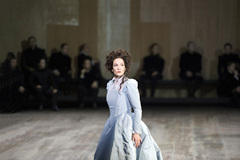| Opera Reviews | 26 April 2024 |
An atmospheric new Maria Stuarda from Christoph Loyby Moore Parker |
|
| Donizetti: Maria Stuarda Theater an der Wien 21 January 2018 |
|
|
Most convincing is Alexandra Deshorties who - with her fiercely-intense reading as Elisabetta - musters the closest feasible tone to convince dramatically. Any passages requiring agility have been well-integrated and polished, and her dusky, somewhat rough-edged, soprano is capable of the part’s temperamental outbursts, while only missing an ideal chest tone here and there to enrich her palette of vocal expression. Marlis Petersen presents an interesting Maria who convincingly progresses from initial cool self-containment to hysterical collapse after confronting Elisabeth, through a display of intimate tenderness with Roberto and again in her plaintive grand finale with the ensemble. While her musicianship and intent are always evident, her instrument and technique remain ideally destined for other pastures. Norman Reinhardt’s Roberto too lacked the necessary vocal substance - at times virtually capitulating to the role’s demands and slipping into passages of “marked” tone lacking the support and depth of an appropriate bel canto “piano” or “mezzaforte”. His vitality and engagement with the remaining protagonists were his main assets on this occasion. Stefan Cerny’s Talbot was rather imposing, but blustery in tone, lacking vocal elegance, and a shade under pitch at times. The remaining cast was solid, with a particularly strong contribution from the Arnold Schoenberg Chor, whose finale ranked among the evening’s highlights. Christof Loy and his team deserve laurels for an atmospheric setting - thanks largely to Katrin Lea Tag’s mammoth revolving disc which encompasses the entire stage area, to be rotated and angled as desired (alas, with burrs and clicks in the mechanics), and - in combination with Bernd Purkrabeks’s clever lighting - which fluidly created interesting optics and vertical dimension. A bench-like row of seating along the rear cylindrical wall together with almost constant ensemble presence deprive the leads of any sense of privacy or succor, with costumes at times discarded in public, and eavesdropping on interaction the palace norm. The two female leads obviously enjoyed thoughtful and intense coaching, whereby the remaining protagonists came across as rather standard in design. The general ensemble tended to hyperactivity - often to no apparent cause and at times detracting from the substance of the piece (most particularly in the great confrontation scene, where Donizetti has well taken care of the drama if the two main protagonists are left unhindered). Impressive period costumes were discarded after the interval to bow to contemporary black and white suits for all. Paolo Arrivabeni did an excellent job with the ORF Radio-Symphonieorchester Wien, capturing the work’s style with precision and warmth, and negotiating the resources in the pit with those on stage to ideally match the intimate framework of the venue.
|
|
| Text ©
Moore Parker Photo © Monika Rittershaus |

 In many respects this production satisfies the eye (if not necessarily the ear) in an austere single setting with a cast eclipsing their vocal suitability through their physical attributes and stage craft. Indeed, the Achilles’ heel of this production is a lack of true Italianate vocal substance and bel canto technique throughout.
In many respects this production satisfies the eye (if not necessarily the ear) in an austere single setting with a cast eclipsing their vocal suitability through their physical attributes and stage craft. Indeed, the Achilles’ heel of this production is a lack of true Italianate vocal substance and bel canto technique throughout.





